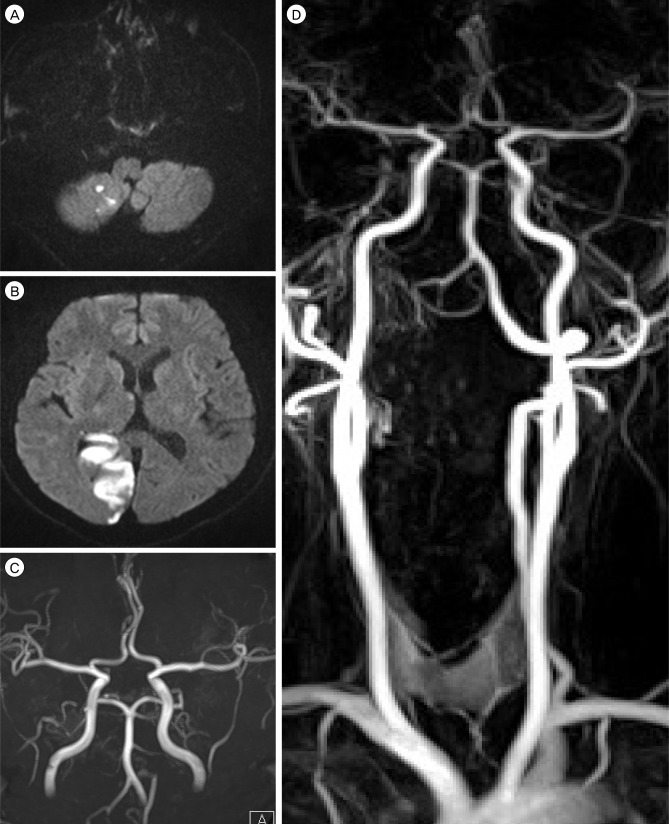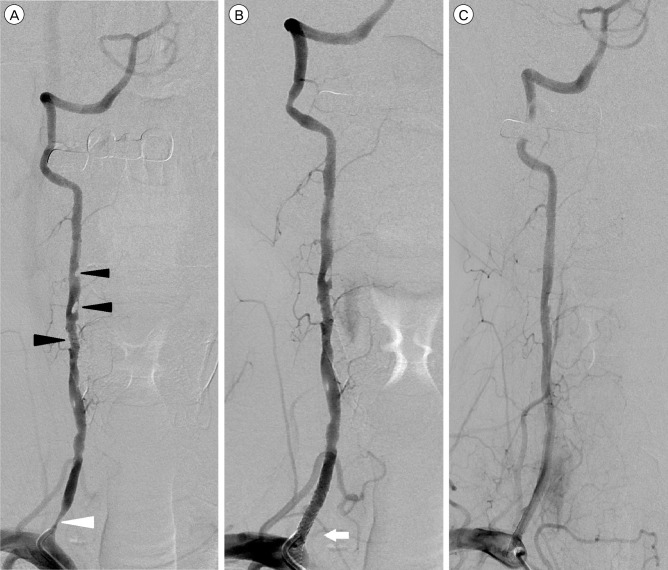J Cerebrovasc Endovasc Neurosurg.
2014 Sep;16(3):281-286. 10.7461/jcen.2014.16.3.281.
Spontaneous Thrombolysis of Multiple Thrombi at Distal Region of Hypoplastic Vertebral Artery After Stent-assisted Angioplasty on Vertebral Artery Origin Stenosis: Angiographic Follow-up
- Affiliations
-
- 1Department of Neurosurgery, Myongji St. Mary's Hospital, Seoul, Korea. nshs@catholic.ac.kr
- KMID: 1963168
- DOI: http://doi.org/10.7461/jcen.2014.16.3.281
Abstract
- Vertebral artery hypoplasia (VAH) can be easily overlooked if the contralateral side vertebral artery is intact, because of compensation by the contralateral artery or cerebral collateral network. The clinical relevance and hemodynamic impact of VAH is still controversial. However, VAH has recently been considered a risk factor for posterior circulation ischemia. Ischemic stroke is seldom caused by free floating thrombi (FFT) in the artery. Pathophysiology of FFT has not yet been clarified. The state of reduced blood flow such as a vertebral artery origin stenosis may cause FFT. Their instability may make them sources of recurrent artery to artery embolism. Patients with FFT will require appropriate medical and endovascular treatment. The current case illustrates a short-term angiographic change of spontaneous thrombolysis of VAH and multiple thrombi at the distal region of the stenosed lesion after stent-assisted angioplasty for a vertebral artery origin stenosis.
Keyword
MeSH Terms
Figure
Reference
-
1. Amole AO, Akdol MS, Wood CE, Keyrouz SG, Erdem E. Endovascular management of symptomatic vertebral artery origin stenosis in the presence of an acute thrombus. J Neurointerv Surg. 2012; 7. 4(4):e11. PMID: 21990503.
Article2. Bamford J, Sandercock P, Dennis M, Burn J, Warlow C. Classification and natural history of clinically identifiable subtypes of cerebral infarction. Lancet. 1991; 6. 337(8756):1521–1526. PMID: 1675378.
Article3. Bhatti AF, Leon LR Jr, Labropoulos N, Rubinas TL, Rodriguez H, Kalman PG, et al. Free-floating thrombus of the carotid artery: literature review and case reports. J Vasc Surg. 2007; 1. 45(1):199–205. PMID: 17210411.
Article4. Wang Y, Cai A, Liu L, Wang Y. Sonographic diagnosis of congenital variations of the extracranial vertebral artery and assessment of its circulation. J Ultrasound Med. 2009; 11. 28(11):1481–1486. PMID: 19854962.
Article5. Caplan LR, Baker R. Extracranial occlusive vascular disease: does size matter? Stroke. 1980; Jan-Feb. 11(1):63–66. PMID: 7355432.6. Chuang YM, Huang YC, Hu HH, Yang CY. Toward a further elucidation: role of vertebral artery hypoplasia in acute ischemic stroke. Eur Neurol. 2006; 55(4):193–197. PMID: 16772715.
Article7. Chuang YM, Hwang YC, Lin CP, Liu CY. Toward a further elucidation: role of vertebral artery hypoplasia in migraine with aura. Eur Neurol. 2008; 59(3-4):148–151. PMID: 18057902.
Article8. Furie B, Furie BC. Mechanisms of thrombus formation. N Engl J Med. 2008; 8. 359(9):938–949. PMID: 18753650.
Article9. Giannopoulos S, Markoula S, Kosmidou M, Pelidou SH, Kyritsis AP. Lateral medullary ischaemic events in young adults with hpoplastic vertebral artery. J Neurol Neurosurg Psychiatry. 2007; 9. 78(9):987–989. PMID: 17702781.10. Hagedorn I, Vögtle T, Nieswandt B. Arterial thrombus formation. Novel mechanisms and targets. Hamostaseologie. 2010; 8. 30(3):127–135. PMID: 20680230.11. Igawa T, Nagamura Y, Ozeki Y, Itoh H, Unemi F. Stenosis enhances role of platelets in growth of regional thrombus and intimal wall thickening in rat carotid arteries. Circ Res. 1995; 8. 77(2):310–316. PMID: 7614718.
Article12. Kalangos A, Baldovinos A, Vuille C, Montessuit M, Faidutti B. Floating thrombus in the ascending aorta: a rare cause of peripheral emboli. J Vasc Surg. 1997; 7. 26(1):150–154. PMID: 9240336.
Article13. Katsanos AH, Kosmidou M, Giannopoulos S. Vertebral artery hypoplasia in posterior circulation cerebral ischemia. Clin Neurol Neurosurg. 2013; 7. 115(7):1194–1195. PMID: 22944469.
Article14. Katsanos AH, Kosmidou M, Kyritsis AP, Giannopoulos S. Is vertebral artery hypoplasia a predisposing factor for posterior circulation cerebral ischemic events? A comprehensive Review. Eur Neurol. 2013; 70(1-2):78–83. PMID: 23816871.
Article15. Kim SD, Hwang JK, Lee JH, Cho HJ, Sung GY, Moon IS, Kim JI. Free floating thrombus of the aorta: an unusual cause of peripheral embolization. J Korean Surg Soc. 2011; 3. 80(3):204–211.
Article16. Park JH, Roh JK, Kwon HM. Ischemic stroke patterns and hemodynamic features in patients with small vertebrobasilar artery. J Neurol Sci. 2009; 12. 287(1-2):227–235. PMID: 19682709.
Article17. Savage B, Almus-Jacobs F, Ruggeri ZM. Specific synergy of multiple substrate-receptor interactions in platelet thrombus formation under flow. Cell. 1998; 9. 94(5):657–666. PMID: 9741630.
Article18. Vilimas A, Barkauskas E, Vilionskis A, Rudzinskaite J, Morkunaite R. Vertebral artery hypoplasia: importance for stroke development, the role of the posterior communicating artery, possibility for surgical and conservative treatment. Acta Med Litu. 2003; 10(2):110–114.19. Watanabe M, Takahashi A, Hashizume Y, Motegi Y, Furuse K. The correlation between vertebral artery asymmetry and pontine infarction- an MR angiography study. Rinsho Shinkeigaku. 1992; 7. 32(7):708–712. Japanese. PMID: 1291160.
- Full Text Links
- Actions
-
Cited
- CITED
-
- Close
- Share
- Similar articles
-
- Acute Vertebral Artery Origin Occlusion Leading to Basilar Artery Thrombosis Successfully Treated by Angioplasty with Stenting and Intracranial Fibrinolysis
- Stent Assisted Coil Embolization of a Dissecting Aneurysm of the Vertebral Artery: A Case Involving a Patient with Hypoplasia of the Contralateral Vertebral Artery
- Usefulness of Drug-Eluting Stents in Angioplasty and Stenting of the Vertebral Artery Origin : Comparison with Bare Stents: Clinical Research
- Two Cases of Aberrant Vertebral Artery Originating from Aortic Arch Distal to Left Subclavian Artery
- The Difference of Each Angiographic Finding After Multiple Stent According to Stent Type in Bilateral Vertebral Artery Dissection



